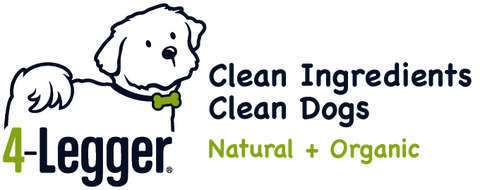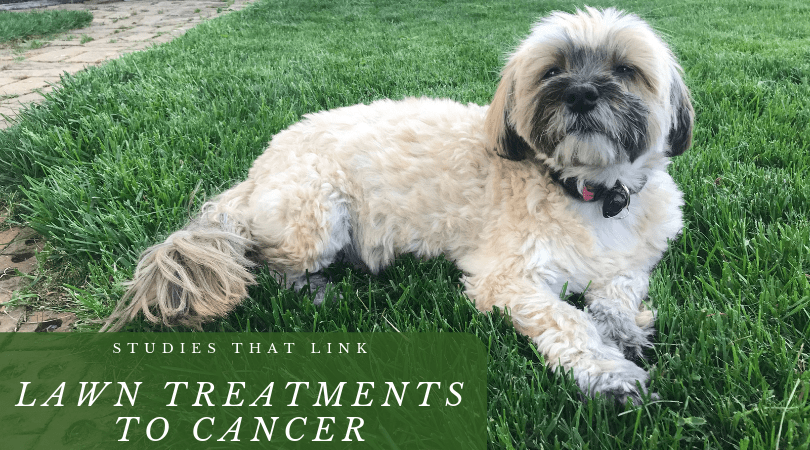Studies that Link Lawn Treatments to Canine Cancer
When I walk my dogs we pass by "chemical lawns" and "safe lawns".
"Chemical lawns" are the perfect green lawns that have little signs posted once a month warning you to stay off the lawn "until it is dry".
"Safe lawns" usually have more weeds and dandelions but those are the lawns I want my dogs to "do their business" on!
My dogs have gotten used to me saying "No, that is a chemical lawn" and are pretty good at trying to hold it until we get to a "safe lawn".
I'm sure there are lawns out there like my own that are the exception to this rule. Our lawn is organic and safe but isn't full of weeds. We use organic lawn care on our lawn with herbicidal vinegar and corn ethanol on weeds as they pop up.
Sadly, there are a lot more chemical lawns than there are safe lawns in my neighborhood.
Yet, the scientific evidence of the dangers of lawn care treatments is mounting and irrefutable.
When my own dog was diagnosed with penile cancer in 2010, I started doing research on lawn treatments.
With tears in my eyes as I write these words, I admit, I had been guilty of trusting when I shouldn't and not being the advocate for my dogs that I should have been.
Over the past 20 years there has been mounting scientific evidence that shows a clear link between lawn treatments and cancer in dogs.
A study from back in 1991 identified a link between canine malignant lymphoma and the use if 2,4 - Dichlorophenoxyacetic acid herbicides.
A 1999 study measured the amount of 2,4-Dichlorophenoxyacetic acid tracked into the house after a yard was treated (yes - after the lawn was dry it was still tracked into the house). The study, conducted by the EPA found before the lawn treatment there was 0.5 μg/m2 2,4-D bulk dust on the floor. After the lawn treatment the dust level of 2,4-D in the living room was 6 μg/m2, with a range of 1−228 μg/m2 on all carpeted floors. The warning was of course that 2,4-D was being found inside the house from a treatment done outdoors that doesn't "dry" and stay outdoors, as is routinely claimed.
A 2011 study called "Animal Sentinels for Environmental and Public Health" reviewed findings relating cancers in animals to environmental toxins and how they are an indicator of what is happening in human cancer linkages. Not a new concept. In the early 1900s birds and mice were used in mines to detect carbon monoxide dangers.
In 2012, a six-year study from Tufts University linked the chemicals used on lawns and flea and tick treatments with canine malignant lymphoma (CML). The study said the risk of CML was 70% higher.
In 2013, just a year before Henry Clay died after his third cancer diagnosis, I read a study that found herbicides in the urine of dogs after lawns were treated and in 1/2 of the dogs where the pet parent's lawn wasn't treated.
Another 2013 study concluded that 2,4-D herbicides and other lawn chemicals significantly increase the risk of canine bladder cancer. If a breed is genetically susceptible to bladder cancer the risk is higher. Beagles, Scottish Terriers, Shetland Sheepdogs, West Highland White Terriers, and Wire Hair Fox Terriers are all known to a genetic predisposition to bladder cancer.
The bottom line is our dogs are dying from cancer in alarming rates.
Nearly 50% of dogs over the age of 2 will die from cancer.
I don't want you to lose your dog to cancer before you realize your actions (like mine) contributed to your dogs cancer. We have to be willing to give up things or methods that are convenient for us if they are causing health problems for our pets.
Another easy way to reduce your dog's exposure to environmental toxins is by using organic dog shampoo. 4-Legger's USDA certified organic dog shampoo is safe and non-toxic, posing no health risks to your dog or you!
Giving your dog's a quick leg wash with 4-Legger when you get home from your walk will reduce their exposure to environmental toxins. Remember, your dog does lick their legs - so whatever is on them will get in them!
Follow our DIY recipe for making your own all natural dog wipes.
Wiping your dog's legs off is a small thing but an important step you can take to begin reducing toxins in your dog’s environment.
Big change always starts with small steps and our dog’s lives are worth our best effort.
We've compiled the scientific journals and articles that identify toxicity of lawn treatments and the links to canine cancer. PLEASE help us to spread the word about the dangers of lawn treatments.
Articles and Scientific Journals Linking An Increase in Canine Cancer to Lawn Treatments
- Nishioka MG, Burkholder HM, Brinkman MC, Lewis RG. Distribution of 2,4-Dichlorophenoxyacetic Acid in Floor Dust throughout Homes Following Homeowner and Commercial Lawn Applications: Quantitative Effects of Children, Pets, and Shoes. Environmental Science & Technology. 1999 33 (9), 1359-65. https://pubs.acs.org/doi/abs/10.1021/es980580o
- Biki B. Takashima-Uebelhoer, Lisa G. Barber, Sofija E. Zagarins, Elizabeth Procter-Gray, Audra L. Gollenberg, Antony S. Moore, and Elizabeth R. Bertone-Johnson. Household Chemical Exposures and the Risk of Canine Malignant Lymphoma, a Model for Human Non-Hodgkin's Lymphoma. Environ Res. 2012 Jan: 112: 171-176.
- Hayes HM, Tarone RE, Cantor KP, et al. Case-Control Study of Canine Malignant Lymphoma: Positive Association With Dog Owner’s Use of 2, 4-Dichlorophenoxyacetic Acid Herbicides. JNCI: Journal of the National Cancer Institute 1991;83, pp 1226–31. https://academic.oup.com/jnci/article-abstract/83/17/1226/1020991/Case-Control-Study-of-Canine-Malignant-Lymphoma?redirectedFrom=fulltextThinkAboutNow. Studies Link Canine Cancers to Lawn Chemicals. ThinkAboutNow. Website. 010117 http://thinkaboutnow.com/2017/06/studies-link-canine-cancers-to-lawn-chemicals/
- Reiff JS. Animal sentinels for environmental and public health. Public Health Reports. 2011;126(Suppl 1): 50-57. https://www.ncbi.nlm.nih.gov/pmc/articles/PMC3072903/
- Thörn Å, Gustavsson P, Sadigh J, et al. Mortality and cancer incidence among Swedish lumberjacks exposed to phenoxy herbicides. Occupational and Environmental Health. 2000; 57:718-20. https://oem.bmj.com/content/oemed/57/10/718.full.pdf
- Hoar, S.K., A. Blair, F.F. Holmes, C.D. Boysen, R.J. Robel, R. Hoover, J.F. Fraumeni, Jr. (1986). Agricultural Herbicide Use and Risk of Lymphoma and Soft-Tissue Sarcoma, JAMA 256:9:1141-1147.
- Wagner, Sheldon L. (1980). Clinical Toxicology of Agricultural Chemicals. Environmental Health Sciences Center, Oregon State Univ., Corvallis, OR.
- Gosselin, R.E., R.P. Smith, H.C. Hodge (1984). Clinical Toxicology of Commercial Products, Williams and Wilkins, Baltimore, MD.
- Canadian Centre for Toxicology (1987). Expert Panel Report on Carcinogenicity of 2,4-D, Ontario Pesticide Advisory Committee of the Ontario Ministry of the Environment, Toronto, Ontario, Canada.
- Schlop, R.N., M.H. Hardy, and M.T. Goldberg. 1990. Comparison of the activity of topically applied pesticides and the herbicide 2,4-D in two short-term in vivo assays of genotoxicity in the mouse Fundamentals of Applied Toxicology. 15:666-675
- Zahm, S.H. Weisenburger, D.D., Babbitt, P.A. et.al. 1990. A Case-control Study of Non-Hodgkin's Lymphoma and the Herbicide 2,4- dichlorophenoxyacetic acid (2,4-D) in Eastern Nebraska. Epidemeology 1:349-356.
- Howard, Philip H. Handbook of Environmental Fate and Exposure Data for Organic Chemicals. Lewis Publishers Chelsea, Michigan.
- Pesticide Information Project. Extension Toxicology Network. 2,4-D. Website. 9/93. http://pmep.cce.cornell.edu/profiles/extoxnet/24d-captan/24d-ext.html
- Reynolds PM, Reif JS, Ramsdell HS, Tessar JD. April-May 1994. Canine Exposure to Herbicide-Treated Lawns and Urinary Excretion of 2,4-D Acid. Cancer Epidemiology Biomarkers & Prevention. 3(3):233-237. https://www.ncbi.nlm.nih.gov/pubmed/8019373
- Kaneene JB, Miller R. 1999. Reanalysis of 2,4-D Use and the Occurrence of Canine Malignant Lymphoma. Veterinary and Human Toxicology, Vol. 41, No. 2:164170. https://www.ncbi.nlm.nih.gov/pubmed/?term=Reanalysis+of+2%2C4-D+Use+and+the+Occurrence+of+Canine+Malignant+Lymphoma
- Cottam J. Dogs and Exposure to Herbicide 2,4-D. Just Ottawa. Website. http://justottawa.com/articles/worthwhile-causes/164-dogs-and-exposure-to-herbicide-2-4-d.html
- Industry Task Force II on 2,4-D Research Data. The Myth of Cancer in Dogs. 2,4D.com. Website. https://www.24d.org/PDF/Scientific_Backgrounders/The%20Myth%20of%20Cancer%20in%20Dogs.pdf
- Takashima-Uebelhoer BB, Barber LG, Zagarins SE, et al. Household Chemical Exposures and the Risk of Canine Malignant Lymphoma, a Model for Human Non-Hodgkin’s Lymphoma. Environmental Research. 2012;112:171-176. https://www.ncbi.nlm.nih.gov/pmc/articles/PMC3267855/
- Glickman LT, Raghavan M, Knapp DW, Bonney PL, Dawson MH. Herbicide exposure and the risk of transitional cell carcinoma of the urinary bladder in Scottish Terriers. Journal of the American Veterinary Medical Association. 2004;224:1290–7. https://www.ncbi.nlm.nih.gov/pubmed/15112777
- Knapp DW, Peer WA, Conteh A, et al. Detection of herbicides in the urine of pet dogs following home lawn chemical application. The Science of the Total Environment. 2013 Jul 1;456-457:34-41. https://www.ncbi.nlm.nih.gov/pubmed/23584031
- Berson S. Their dogs kept getting cancer and dying. All signs pointed to a local park. The Herald Sun. April 10, 2018. https://www.heraldsun.com/news/nation-world/national/article208488524.html
- Gómez-Barroso D, García-Pérez J, Lopez-Abente G, et al. Agricultural crop exposure and risk of childhood cancer: new findings from a case-control study in Spain. International Journal of Health Geographics. 2016; 15:18. https://ij-healthgeographics.biomedcentral.com/articles/10.1186/s12942-016-0047-7
- Malagoli C, Costanzini S, Heck JE, et al. Passive exposure to agricultural pesticides and risk of childhood leukemia in an Italian community. International Journal of Hygiene and Public Health. 2016; 219:742-748. https://www.ncbi.nlm.nih.gov/pubmed/27693118





